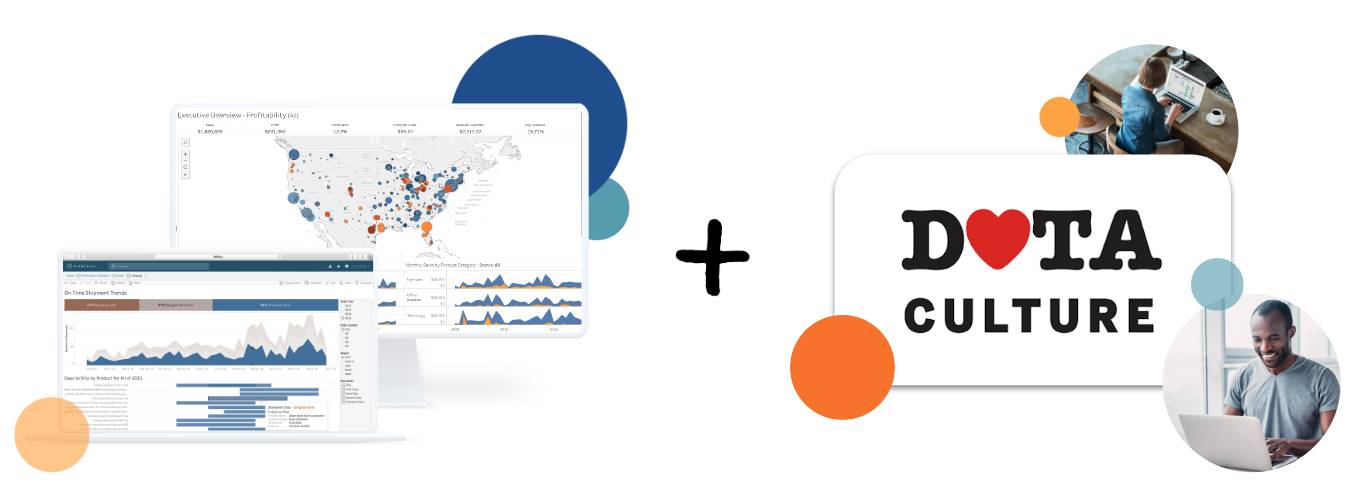Get to Know Tableau Blueprint
Learning Objectives
After completing this unit, you’ll be able to:
- Explain why data-driven organizations perform better.
- Describe the Tableau Blueprint methodology.
- List the first steps you take on the Tableau Blueprint journey.
- Explain what modern governance means.
Data-Driven Organizations Perform Better
At Tableau, we’re on a mission to help people see and understand data. That mission means more to us now than ever because we’ve seen how data enables people to do incredible things. For example, data-driven organizations can get a better picture of what’s happening in their business, make smarter decisions faster, and align everyone around those decisions because they are based on data, not opinions.
According to the IDC InfoBrief, Why You Should Care About Data Culture, data-driven organizations are:
- 23x more likely to add customers
- 1.5x more likely to grow revenue by > 10%
- 9x more likely to retain customers
How do organizations achieve these impressive results? Successful data-driven organizations invest strategically in deploying the right technology and fostering the right culture.

Let’s start with the culture part of that equation. Organizations that successfully scale analytics have a strong data culture. In a data culture, everyone in the organization can work with the data they need. When an organization creates a strong data culture, there’s a fundamental shift in how people think about and act on data. Decisions throughout the organization become more data-driven.
Now, let’s consider the technology. The right data and analytics technology is foundational to building a successful data culture. Technology like the Tableau Platform lowers the barriers for new users and brings power to advanced users, giving you the ability to create a complete picture of your data that you can trust. With this big picture comes the ability to make smarter, faster decisions powered by self-service analytics capabilities.
So, you’re ready to create a thriving data culture and implement powerful, accessible technology that brings data analytics to everyone, to achieve a successful data-driven organization. But how exactly do you do this?
Meet Tableau Blueprint
Tableau Blueprint is a proven methodology that shows you how to scale your analytics program responsibly. It provides prescriptive, repeatable guidance to help you broaden, deepen, and scale the use of data and build a thriving data culture in your organization. With the Tableau Blueprint, we’ve curated best practices backed by the expertise of thousands of customers to help you turn repeatable processes into core capabilities, so you can quickly see business value from your investments. And the best part of all is that it's free to use!
This module provides an overview of how your organization can use Tableau Blueprint to scale the use of data and analytics and the key resources that help you get started.
What Are the First Steps?
You start your Tableau Blueprint journey by defining your analytics strategy. This step is vital to ensuring success with your analytics investment.
At this step, you consider your organization’s business goals and objectives and ask, “How can we use data to drive forward those business outcomes?” You can create a more efficient analytics program when you directly link your analytics projects to specific success metrics, objectives, and overarching company strategies.
Becoming a data-driven organization requires new skillsets, processes, and behavior changes from all users within your organization. Orchestrating this change requires partnership from a broad set of stakeholders. This leads us to the next step, identifying executive sponsors and forming project teams.
This group can include line-of-business executives, individuals from data and technology, data stewards, and even your consumers. Your executive sponsors and project teams play a critical role in the initial deployment of your analytics environment. And they help scale the use of data and analytics by fostering the behaviors and beliefs that lead to a successful data culture.
Here are the key roles we see in successful data-driven organizations.
- Business leaders to set the vision and align resources to the initiative
- Server admins to monitor and maintain server performance
- Project leaders to manage certified data sources, content discoverability, and ensure the project is set up to support follow-up self-service solutions
- Data stewards to manage and advise on data sources
- Content authors to develop analyses
- Community leaders to help users access resources and accelerate their learning journey
Once you’ve defined your strategy, sponsors, and project teams, you’ve got the foundation you need to get to work. Let’s see what that looks like.
Get to Know the Core Pillars
Tableau Blueprint comprises three core pillars: agility, proficiency, and community. Each core pillar is a focus area that’s segmented into different sub-topics or stops that outline evidence-based best practices.
| Core Pillar | Stops | Focus |
|---|---|---|
|
Agility |
Deployment, Monitoring, Maintenance |
Deploy a secure, stable environment that evolves as business needs change. |
|
Proficiency |
Education, Measurement, Analytics Best Practices |
Educate your people to see and understand data for decision-making. |
|
Community |
Communications, Engagement, Support |
Build a community of data-enthusiasts and experts to alleviate support-pressures from your centralized teams and celebrate data-driven wins. |
Embrace Modern Governance
As you apply the practices in Tableau Blueprint, your organization should work to strike the right balance between security and data access for exploration.
At Tableau, we believe in modern governance, a framework that balances security and privacy with openness and sharing. Tableau Blueprint shares our guidance on how to strike that balance by considering controls, roles, and processes.
It’s important to note that you should revisit governance often. The pace of change in the world is only accelerating—business needs, data and content in your environment, and users are ever-changing. A good governance model evolves with those changes so your organization can successfully drive adoption and safely use data.
Ready to dive deeper? Let’s take a closer look at the core pillars next.